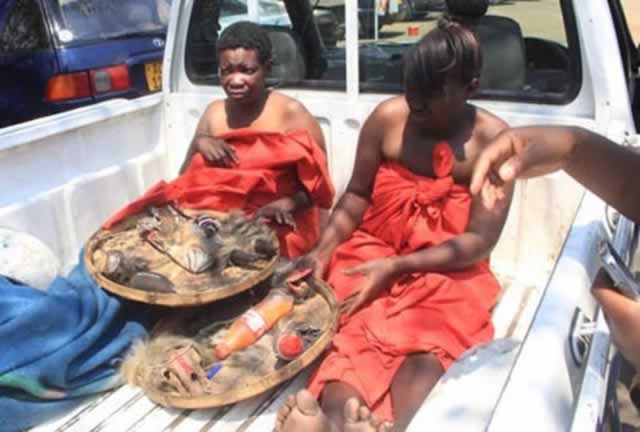The injustice of witchcraft accusation


Last year Elmet Mbewe and Christine Nyamupandu were jailed for pretending to be witches in Budiriro. The pair was allegedly hired by a “prophet” so that he could prove his “powers” and gain more clients
Sekai Nzenza On Wednesday
It’s a belief tied to prevailing superstitions, difficult social and economic situations, and natural disasters, lack of rain, personal rivalry or jealousies
UNTIL a month ago, there was a farmer of Malawian extraction who grew the best sweet potatoes and okra along the Save River. He also kept tasty village chickens we call road runners.
His eggs were the big original ones with yellow yolk. If you needed bags of millet, sorghum, chillies, fresh vegetables and tomatoes, this Malawian man called Kamanga could sell it to you, any time of the year, at a very reasonable price.
But Kamanga is gone now. My cousin Piri and niece Shamiso went down to the Save valley last month to buy chickens and eggs, as we often did, only to find Kamanga’s village deserted. There was not a sign of life. The cow dung in the kraal was all dry, which meant no cows had slept in there for a while.
The chickens and goats were gone. The place was locked up. “What happened?” we asked the neighbours further down the river. With much sadness, this is what they told us: Kamanga and his wife MaMoyo had both been accused of witchcraft by the new apostolic faith prophet whose church was growing in the valley by the day.
In a vision, the prophet said God came to him and said a foreign man with no totem was living among the people of God, vanhu vaMwari. This foreign man was not a man of God.
Because he was a foreigner, he had powers of evil to kill and to accumulate other people’s wealth without them knowing or even seeing it. According to the prophet’s vision, it was through Kamanga’s witchcraft powers that some children had died of measles.
Not only that, it had been revealed to the prophet that Kamanga was also responsible for the deaths of a few people at the white man’s farm where he used to work before the land resettlement.
Some members of the congregation shook their heads, looked at their small harvests and pointed to Kamanga, saying his witchcraft powers was responsible for their loss and bad luck.
Kamanga was married to MaMoyo, whose mother is from around here.
They had met on a white man’s farm somewhere near Bindura back in the late 1990’s.
When the land issues commenced in 2000, Kamanga and his wife quickly packed their belongings and came here to ask Sabhuku, the kraal-head, for land. Since Sabhuku was related to MaMoyo’s mother, he allocated them virgin land along the Save river.
Over the past 10 years or more, Kamanga and his wife built a beautiful thatched home and farmed the black and red soils near the river.
Kamanga could also fish, using special skills that his Malawian father had taught him when they used to fish in the Mazowe River.
This “revelation” of witchcraft was received as truth by most people who live along the river.
Kamanga and Mamoyo did not wait to be told to leave the village. You know when you are no longer welcome in the village.
They left their cattle in the hands of other relatives. Then they hired a Kombi and left for the resettlement areas somewhere up north near Mt Darwin. The shadow of witchcraft accusations hangs silently over their silent homestead.
When Christian missionaries came here a long time ago, they regarded witchcraft accusations as a form of primitive practice by some uncivilised people of Africa. They said the practice would eventually die away due to the power of Christianity.
Later on, the Rhodesian colonial authorities worked very hard to eradicate witch hunts. They criminalised witchcraft accusation and said it was an offence to brand someone a witch or identify a person as a wizard. They introduced the Witchcraft Suppression Act to stop the victimisation of people, mostly women, accused of witchcraft.
When I was at St Columbus Primary School students were punished for referring to anyone’s mother as a witch. To say your mother is a witch, mai varoyi, was an offence punishable by carrying water from the spring well five kilometres away and watering the school garden all day.
Sometimes you would get 20 bottom thrashings or get suspended from school. In the village, among the adults, calling anyone a witch required making a public apology at Sabhuku, the kraal head’s court and payment of a whole beast.
In those colonial days before independence, we feared illness and death from witchcraft. We believed that there were many witches in the village homestead and in many other villages nearby. These witches rode hyenas and carried owls. They walked many miles, feasting on bodies in fresh graves. They particularly liked young children, fat people and successful people.
There were many stories of witches being nailed on the breasts when caught in the act. A woman believed to be a witch could wake up one day to find a stretcher or a dara, made with planks of trees and bark placed on her doorstep. The presence of a dara meant she had to leave the village immediately or risk being chased away by men wielding sticks and spears.
Although the witches roamed these valleys, hardly anyone died. Death was rare in the village. It was mostly the old people who died of illness to do with age. The only young death I remember very well was that of my cousin Anna.
They said an evil witch and her group of witches ate her because she was very fair-skinned and fat. She was eight, or maybe 10, I cannot remember. She was my father’s brother’s daughter, the same way Piri is to me. We played together in the village compound.
Sometimes Anna did not come out to play because her joints and her chest were sore, aive nechikosoro.
Anna had nyora or tattoo-like marks on the thighs, stomach and both ankles to protect or heal her from illnesses caused by witches.
One day after eating sadza and dried meat, she started vomiting. All night, she vomited. By morning, they said Anna was dead. They buried her on the anthill, right in the fields behind the homestead.
It was whispered that the witches responsible for Anna’s death rode their hyenas and raided Alice’s grave in the pitch night darkness when were sound asleep. Anna’s flesh was all gone and only her skeleton remained. We avoided walking near Anna’s grave in case her angry skeleton leapt out to curse and swear at the witches.
To prevent more deaths in the village compound after Anna’s death, my grandmother, Mbuya VaMandirowesa, and the other elders called Murefu, the village n’nga or traditional healer.
Murefu came one dark night to cut protective nyora marks on all the village children. He wore a head dress made of brown feathers, a leopard skin and some other rag like clothing. He was a big tall man with scary eyes. I recall how he walked in, unsmiling, with his bag full of magical tools.
Murefu cut nyora to protect us from the diseases of the past.
From then on, we felt protected from witchcraft. Up to this day, my siblings and I carry the black nyora or tattoo lines on our bodies. Then we moved to boarding school and the city.
Once we left the village, we shared the missionary belief that witchcraft will one day die away, as we become more Westernised.
Back here in these villages, sometimes we like to think witchcraft was conquered by Christian beliefs and scientific explanations.
But that is not true. Witch-hunting in Zimbabwe or anywhere in Africa or Europe for that matter is nothing new.
It’s a belief tied to prevailing superstitions, difficult social and economic situations, and natural disasters, lack of rain, personal rivalry or jealousies.
Sometimes hunger, poverty and depravation can also create jealousies leading to sadness, anger and desire to compete or even destroy a competitor.
This belief in witchcraft continues to come up again, just like it did in the last dry season when there were so many witch-hunting ceremonies around the villages.
In many parts of rural Zimbabwe, there were many gangs, teams or groups of people calling themselves Bere Dvuku, Red Hyena or Garwe the Crocodile. Some of them were young men wearing gold necklaces, driving Mercedes Benzes, drinking beer and playing pool at the local shops when they are relaxing in between witch hunting.
Kamanga was not from here and his hard work may have caused some jealousy. Who knows why a prophet would see a witch in such a beautiful, kind, generous and hard-working family like Kamanga’s?
One day, we should be able to ask prophets to give us evidence on the witchcraft accusations that occur with such randomness.
Like the neighbours who knew Kamanga well, we are left with lingering questions. What if the prophet who accused Kamanga of witchcraft was not a man of God?
What if he had a personal conflict or jealousy streak against Kamanga and his wife?
Since we are all Zimbabweans now, how can we point fingers at a fellow villager and call him a foreigner? But there is no one to ask these questions.
Kamanga’s village is deserted. He will never come back to sell the road runner chickens and their brilliantly yellow organic egg york.
His departure was just one of those tragic village situations of injustice.
Dr Sekai Nzenza is CEO of Rio Zim Foundation. She writes in her personal capacity.









Comments